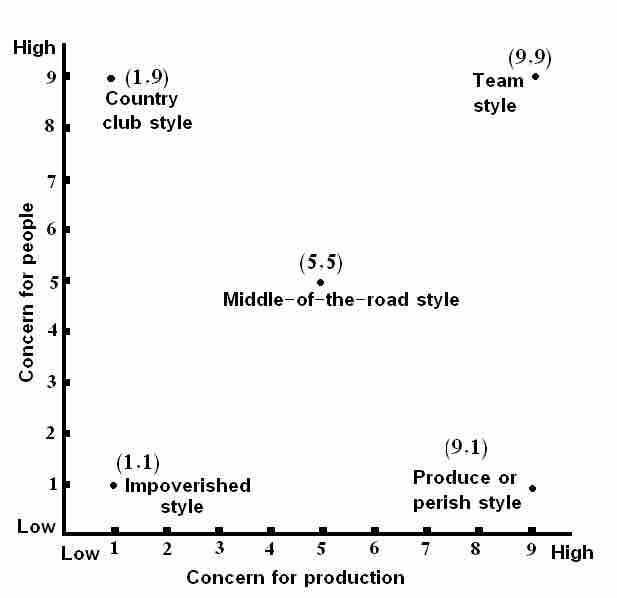Overview of Leadership
Leadership is a field of study (and core ability) that focuses on the ability of an individual or group to "lead" or guide other teams, people, or even entire organizations. The evolution of the field of leadership is quite extensive, ranging from the following perspectives:
- Trait theories
- Attribute patterns
- Behavioral and style theories
- Situational and contingency theories
- Functional theories
- Integrated psychological theories
- Transactional and transformative theories
- Leader-member exchange theories
- Emotional intelligence
Each of these schools of thought are facets of what modern leadership theories try to take into account today, as varying perspectives on leadership are useful to take into consideration the complex, global world of organizations.

Leadership Grid
One perspective on leadership is balancing the well-being of the people who work for you with the efficiency of task completion, as illustrated in this simple chart. The Ohio State Leadership Studies touched upon this concept.
Early Leadership Research
Early methods of research theory centered around trait theories. The basic premise was that certain characteristics of individuals were the ideal indicator of success in a leadership role. In other words, for example, extroverted individuals with a highly developed sense of empathy, confidence, and decisiveness would make good leaders. As you may already be thinking, this perspective on leadership is somewhat limiting, as there are various external factors and situational considerations one should consider when determining if a given individual is a strong fit for leading a specific initiative or organization.
The Ohio State University Leadership Study
While the concept of identifying good leaders based upon individual characteristics had some merit (which has been identified in later research), the Ohio State Leadership study was more interested in which specific behaviors effective leaders executed (compared to ineffective leaders). This consideration and initiating structure of behavior yielded a number of interesting results.
Method
A survey with 150 statements (narrowed down from nearly 2000 potential statements), which was titled the Leadership Behavior Description Questionnaire, was delivered to leaders to identify what types of behaviors were most effective in leading. Nine specific behaviors were identified and measured.
Conclusions
The results of this questionnaire identified two different groupings of four behaviors within the subtopics of consideration and initiating structure.
Consideration
Consideration is the extent to which a leader exhibits concern for the welfare of the members of the group.
With a focus on interpersonal relationships, mutual trust and friendship, the consideration leadership style is people-oriented. This focuses primarily on:
- Being friendly and approachable
- Maintaining equality between leaders, team members, and stakeholders
- Ensuring the personal welfare of group members
- Being accessible to group members
Initiating Structure
The second behavioral element the study identified revolves around roles, objectives, activities, planning, and delegation. Unlike the people-oriented style above, this is a task-oriented perspective that focuses on behaviors such as:
- Setting individual expectations
- Maintaining performance standards
- Scheduling and planning tasks
- Ensuring the group maintains organizational expectations